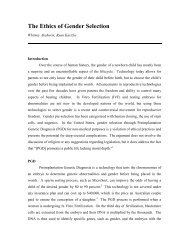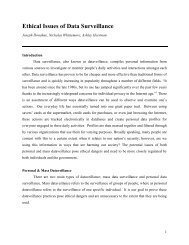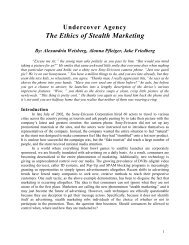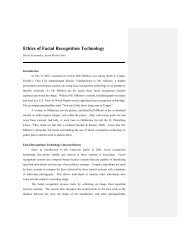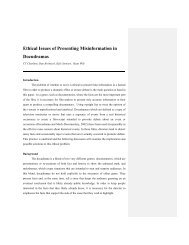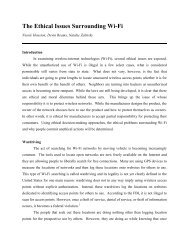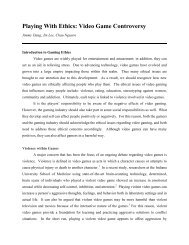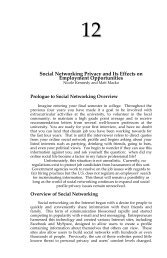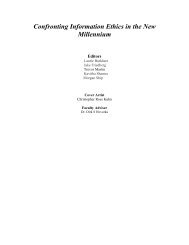Biometrics: Does Convenience Outweigh Privacy?
Biometrics: Does Convenience Outweigh Privacy?
Biometrics: Does Convenience Outweigh Privacy?
Create successful ePaper yourself
Turn your PDF publications into a flip-book with our unique Google optimized e-Paper software.
7<br />
<strong>Biometrics</strong>: <strong>Does</strong> <strong>Convenience</strong> <strong>Outweigh</strong> <strong>Privacy</strong>?<br />
Jarret Roberts and Sejal Patel<br />
Introduction<br />
Eight years ago, the tiny ridges that make up a fingerprint meant<br />
little more than a way for crime scene investigators to identify suspects.<br />
Now, in the world of 2007, they are linked to everything from bank<br />
accounts to national identification systems. Consumers can pay at<br />
grocery stores literally with the touch of a finger, and employees do not<br />
need to carry around security cards because they can use their<br />
fingerprints to gain access to restricted areas. ‚<strong>Biometrics</strong> is the science<br />
of measuring biological characteristics and behaviors for the purpose of<br />
determining or verifying identity‛ (Langenderfer and Linnhoff 314).<br />
Even though fingerprint scanning is the most widely used and known<br />
form, the entire biometrics field is quickly becoming integrated as a<br />
standard in both the consumer and business world. The rapid<br />
expansion of an industry so closely tied to extremely personal<br />
information raises the question: are the conveniences created by<br />
biometrics worth the sacrificed privacy?<br />
Much of the attention surrounding biometrics has focused on<br />
accuracy and reliability (Carpoor 48). While this chapter will touch on<br />
the topics of accuracy and reliability, the main focus will be to explore<br />
the ethics, convenience, and security issues integrated within<br />
biometrics. The first section of this chapter will present a brief<br />
introduction to the topic of biometrics. From there, the role of this<br />
chapter will be to present research findings on the perceptions<br />
surrounding biometrics, regarding the trade off individuals face<br />
between ethics, convenience, and security.<br />
An Overview of <strong>Biometrics</strong><br />
<strong>Biometrics</strong> originally stemmed from the need to identify victims<br />
though forensics (Carpoor 48). While early forms of the technology<br />
required an expert to analyze and make conclusions based on human<br />
experience, the integration of technology allowed biometrics to be<br />
implemented on the mass scale seen today. In early 1998, Visa began the<br />
first commercial integration of biometrics by linking credit accounts to<br />
the fingerprints of participants in a pilot study (Cuneo 24). From there,<br />
the industry grew to reach revenues of over $800 million in 2003 and is
now projected to more than triple by 2008 (Allan 77). In addition to the<br />
aforementioned fingerprint scanning, biometrics includes face<br />
recognition, hand geometry, iris scanning, voice recognition, signature<br />
recognition, retina scanning, ear/lip motion recognition, body odor<br />
analysis, skin reflection analysis, nail bed analysis, body shape analysis,<br />
dental analysis, and DNA recognition. (Langenderfe and Linnhoff). All<br />
of these functions require a two-step process, ‚enrollment‛ and<br />
‚authentication,‛ to verify identity (Langenderfe and Linnhoff 315).<br />
How It Works<br />
<strong>Biometrics</strong> works by first enrolling information and then later using<br />
that information to authenticate an individual’s identity. In the first<br />
step, enrollment, data collected and the individual’s data points are<br />
linked to her identity. The purpose of this first step is to create a data set<br />
that can later be compared to data points during authorization. In the<br />
case of biometrics, enrollment is unique because of the biological and<br />
behavioral information collected. Unlike many current forms of<br />
collected identifiers, such as Personal Identification Numbers (PINs),<br />
the data collected for a biometric data set is physically linked to its<br />
owner. For example, an individual’s fingerprint could be scanned into a<br />
database, and then linked to the identity of the individual it came from.<br />
As will be seen, this link to the physical form is the source of much<br />
convenience, but also a great deal of ethical debate. After enrollment,<br />
new data can be compared to the existing data set through the second<br />
step, authentication. The data being collected is in the form of biological<br />
or behavior attributes. Again using fingerprints as an example, an<br />
individual scans a fingerprint into a system that searches a data set of<br />
fingerprints to determine if there is a match.<br />
Matching is not a simple process. To authenticate these individual<br />
data points against the data set, they must first be translated into a form<br />
that is easily comparable and readable. In order to accomplish this<br />
conversion, physical information, such as fingerprints, is translated into<br />
vectors or equations (Langenderfe and Linnhoff). The equations<br />
generated are easily read and compared to each other by computers<br />
when run through algorithms. Authentication is granted if the equation<br />
fulfills the requirements of the algorithm. In the case of fingerprints, the<br />
scanner would take a digital image of the fingerprint. From this image<br />
an equation would be written describing features, such as a ridge<br />
splitting or the center point, along with the location of these features.<br />
This equation is then run through an algorithm and if the features and<br />
their locations match, authentication is granted.<br />
If authentication is granted it can come in two distinct forms:<br />
identification and verification (Hong, Yun, and Cho 502). Identification,<br />
the first type of authentication, occurs when a newly acquired data<br />
point is compared to a pre-existing set to see if the point can be<br />
identified via the set. In this case, a name or some other identifier would<br />
identify an individual by scanning their fingerprint individually. In the<br />
other type of authentication, verification, a data point is compared to a<br />
set in which it may or may not exist. If, for instance, a security guard<br />
scanned his finger, and that data point existed in the authenticating data<br />
set, he would be verified and granted access without actually being<br />
identified as an individual.<br />
No two scans will ever be exactly alike even if they are of the same<br />
image. For example, fingers placed at slightly different angles create a
much different image than the one created during enrollment. Further,<br />
an individual may have a paper cut, or some other new abnormality,<br />
running across the middle of a finger which was not there when the<br />
original enrollment image was scanned. Thus, even with the most<br />
advanced technology the vector renditions are never exact and limits<br />
must be set as to which data points pass and which do not. Setting very<br />
stringent criteria for matching ensures a much lower likelihood of false<br />
positives. However, setting such stringent limits also drastically<br />
increases the number of false negatives. The opposite is true for setting<br />
an intensely lenient limit. There will be fewer negatives that should<br />
have been authenticated, but false positives will register more often.<br />
While finding a balance between stringent and lenient limits is a<br />
constant source of debate, the effects on society from a false positive<br />
often outweigh those of a false negative. From a company perspective,<br />
it is better to wrongly lock out someone who belongs in a restricted area<br />
than to wrongly grant access to someone who does not belong there.<br />
Users of <strong>Biometrics</strong><br />
<strong>Biometrics</strong> reaches into three main user segments: government,<br />
consumer, and business. With the recent increase in global terrorist<br />
activities, governments are pushing even harder for identification<br />
technologies that are reliable and secure. For example, ‚the U.S.<br />
government is pressuring twenty-six visa-waiver nations to embed<br />
biometric data into their passports‛ (Allan 77). Additionally, ‚next<br />
generation smart cards in Europe, Asia, and Japan promise to include<br />
biometrics for identification, passport visa, and driver’s license<br />
purposes‛ (Allan 77).<br />
The implications of such large-scale implementation are enormous.<br />
If the UK government were to utilize biometric technology in their<br />
national identification cards, it would create a biometric database with<br />
over 50 million entries (Dettmer 26; Hornung 502). Aside from national<br />
implementation, the consumer segment will be the largest group<br />
affected by biometrics. Companies such as Piggly-Wiggly grocery store<br />
and Blockbuster Video are already beginning to allow consumers to link<br />
accounts and even payment to biometric identifiers (Langenderfe and<br />
Linnhoff 327). Finally, businesses are beginning to employ biometric<br />
technology into all aspects of employees’ workdays, from authorization<br />
to print, to accessing restricted areas. For companies, the advantage of<br />
biometrics security is the inability to transfer access. While employees<br />
can let someone borrow an access card and clock each other in, a<br />
fingerprint scanning time clock would prevent such exploitation.<br />
Ethics of Biometric Data Collection<br />
While lost credit cards can be canceled, and PINs reassigned, the<br />
permanence of biometric data magnifies the ethical debate about its<br />
collection. Perhaps one of the greatest concerns revolves around the<br />
possibility of a breach in a biometric database. All too often, it is<br />
reported that personal information on a company’s system or Website<br />
has been compromised. In the case of biometric data, a compromise of<br />
biometric databases would have much more permanence. Once a<br />
fingerprint is compromised, it is impossible to exchange it because of its<br />
physical link to the owner. Individuals cannot simply cancel their
current fingerprint and get a new one. This physical link and<br />
permanence are, however, what make biometrics such a convenience.<br />
The permanence and extreme individuality of biometric<br />
identification factors make data exchange and tracking easier than ever<br />
(Langenderfe and Linnhoff 330-334). The consolidation of identification<br />
biometrics provides, and often leads to one form of identification. In<br />
turn, this allows for easier tracking of individuals. At the same time, the<br />
biometric identification factors are both unique and universal, again<br />
creating an ease of sharing consumer information. While some argue<br />
linking databases could allow the capture of criminals that otherwise<br />
would have dodged apprehension, there is a greater cost to society to<br />
consider. Such ease in tracking could easily be taken to an extreme. It is<br />
possible that tracking could lead to a society where every violation, no<br />
matter how small, is tracked though the use of biometrics. If this were<br />
to escalate, the world could transform into a ‚Big Brother‛ society. It is<br />
also realistic for corporations to be able to track and link consumers’<br />
every interaction with a biometric scanner, permitting the formation of<br />
in depth consumer profiles. Individuals have always had to balance the<br />
convenience of technology with its intrusiveness. Now, however,<br />
technologies such as biometrics utilize one of the last unexploited pieces<br />
of information individuals have, their biological characteristics.<br />
<strong>Convenience</strong> of <strong>Biometrics</strong><br />
While the ethics of biometrics are still a major debate, the potential<br />
convenience is often viewed as the beneficial contribution society will<br />
receive from the technology. <strong>Biometrics</strong> removes the inconvenience of<br />
being without identification. In a survey by New York based <strong>Biometrics</strong><br />
Group, 240 random consumers were questioned as to their preferred<br />
form of security. According to a recent poll by US Banker, fingerprint<br />
scanning ranked nearly three times higher than traditional passwords.<br />
The reason given for such a high ranking was closely linked to the<br />
convenience. Imagine a society where a wallet or purse is a thing of the<br />
past. Additionally, biometric identifiers add convenience because, for<br />
the most part, they do not change over a person’s lifetime, eliminating<br />
the need to physically renew cards. DNA and even finger print samples<br />
taken from a newborn will be nearly identical to those taken from the<br />
same individual decades later. Waiting in line for a license at the<br />
Department of Motor vehicles would no longer be necessary.<br />
Next, since biometric data is a physically stored type of data it<br />
cannot be lost, forgotten, or easily stolen. Thus, remembering many<br />
different passwords or leaving behind credit cards after purchases<br />
would be a thing of the past. Having an identification or credit identifier<br />
that cannot be lost or physically stolen would greatly reduce the fraud<br />
currently seen with credit cards. Finally, biometrics has the potential to<br />
make life more convenient by reducing theft. If computers and cell<br />
phones were integrated with biometric sensors, they would be useless<br />
to anyone but the owners. For thieves, the desire to steal them would<br />
be greatly reduced because the stolen goods would have little value to<br />
anyone except the owner, whose fingerprint is needed to unlock the<br />
goods. The convenience linked to biometric sensors continues to fuel<br />
the debate over its ethics.
Security Implications of <strong>Biometrics</strong><br />
Biometric technologies have tremendous potential to strengthen<br />
national securities by uniquely identifying individuals. As previously<br />
mentioned, many governments are currently putting a great deal of<br />
effort into the development of nationally linked biometric identification<br />
systems. One major problem with such implications is enrollment. In<br />
order for an individual to be authenticated as a criminal or suspect they<br />
must first be enrolled and classified as one. It is unlikely that many<br />
criminals or terrorists will willingly enroll in biometric databases, and it<br />
is likely, these will not be the only groups opposed to enrollment. Some<br />
religious groups, such as Mormons, discourage or even prohibit the use<br />
of technology. If biometric systems were put in place, would these<br />
people then be excluded from societal interaction or would a by-pass<br />
have to be allowed? Any form of by-pass would compromise the<br />
security of the system. However, it will almost certainly be necessary<br />
for such bypasses to exist. It is inevitable that no matter how accurate<br />
the technology behind biometrics becomes, there will still need to be<br />
some way to by-pass the system. Due to the false positives that will<br />
occur, even at the smallest of percentages, and the potential for<br />
technology failure such as a power outage, the overall security of<br />
biometrics will only be as strong as its weakest part.<br />
There are also security concerns about biometric tracking, which is<br />
‚real-time or near-real-time surveillance of an individual,‛ and<br />
mapping a person’s past habits to make or reconstruct someone’s path<br />
(Arthur 6). Such tracking could provide enormous security and is<br />
becoming closer to a reality. Iris scans now can take place from up to<br />
twenty-four inches away (Langenderfe and Linnhoff 319). The<br />
implications of such technology lead to the concern that individuals will<br />
soon be tracked with little knowledge of such happenings. In much the<br />
same way, hidden cameras now cover much of the public and consumer<br />
world; soon, biometric scanners could track individuals. Again, it is a<br />
trade off of convenience and privacy. It would be convenient as a<br />
society, if criminals could be located and apprehended in a matter of<br />
moments due to the tracking capabilities. At the same time, our society<br />
must weigh the ethical implications of giving up so much privacy.<br />
Future Obstacles for <strong>Biometrics</strong><br />
The advancement and acceptance of biometric technology globally<br />
shows that consumer acceptance and trust is growing exponentially.<br />
Companies are also adopting biometrics at an amazing rate. The Aite<br />
Group, a research firm in Boston, predicts that in January 2009, 35% of<br />
financial institutions will have deployed biometric technologies (Allen<br />
77). The International Biometric Group of New York also projected in<br />
January, that global biometric revenue would rise from $2.1 billion in<br />
2006 to $5.7 billion in 2010 (Allen 77). However, biometrics must<br />
surmount some very real concerns before becoming common in<br />
everyday life, especially in the areas of cost and accuracy.<br />
Cost is one major concern. Currently, the cost to produce and<br />
implement biometric technology is beyond what many companies can<br />
afford to pass on to their consumers. United Airlines mandated 400 of<br />
its employees to use biometrics technology to gain access to their
network and log their work hours. The total cost for this one biometric<br />
project cost millions of dollars for the United States (Costanzo 6-11). For<br />
smaller companies, the cost of implementing biometric technology may<br />
not be realistic. "Eventually the industry will provide biometric<br />
solutions that will be more acceptable to a wider audience, making it<br />
more affordable to everyone,‛ stated Ken Silveira, the chief information<br />
officer at Bridge Bank in San Jose (Costanzo 6-11). Until economies of<br />
scale combine with cheaper technology, cost will be a major hindrance<br />
on the growth of biometrics.<br />
Another major obstacle facing biometric technology is the<br />
possibility of error. Even though the International Biometric Group<br />
states that in the last decade biometric technology has become ‚a lot<br />
more accurate, with less than a one percent False Rejection Rate (FRR),‛<br />
error is still a major concern (Bruno 41). If in the aforementioned case of<br />
the UK implementing a national biometric system with 50 million data<br />
points, a one-tenth percent FRR occurred, it would mean that 50,000<br />
data points would be falsely rejected. False identification could have<br />
implications just as harmful; ‚Oregon attorney Brandon Mayfield was<br />
wrongly jailed for two weeks because his fingerprint purportedly<br />
matched one found at the scene of the Madrid bombings in March 2004<br />
(Langenderfe and Linnhoff 228). It is highly likely that accuracy will<br />
never reach 100%. With this in mind, society must consider the cost of<br />
error that will occur, compared to the convenience provided.<br />
Research<br />
Design, Methodology, and Approach<br />
As mentioned, the research done for this chapter examined<br />
individuals’ views regarding the sacrifice of privacy for the convenience<br />
that biometric technology provides. To allow the full exploration of this<br />
topic, in-depth personal interviews were conducted with twenty-four<br />
respondents. Respondents were selected to yield a balance of age,<br />
gender, profession, and interests. This allowed a greater variety of<br />
perspective on the subject. A set of ten predetermined questions was<br />
the concentration of the interview. However, respondents were<br />
encouraged to expand upon topics. The questions were designed to<br />
assess the sample perceptions surrounding biometric technology, the<br />
ethical obligation of collecting personal information, how security<br />
weighs in on technology today, and how important convenience is in<br />
individual lives. The interviews were conducted in person and lasted<br />
between fifteen and twenty minutes. Questions were designed with as<br />
little bias as possible to allow respondents to reply positively or<br />
negatively. The focus was to extract trends that either bridged the<br />
entirety of respondents or were isolated within homogeneous segments<br />
of respondents. Thus, major themes regarding ethics, convenience, and<br />
security of biometric technology in individuals’ lives could be<br />
compared to trends regarding the sacrifice of privacy.<br />
Responses on Ethics<br />
‚I do not think it is ethical. It’s the last piece of privacy a human<br />
being has,‛ one respondent begins. Nearly all interviewees expressed<br />
concern about the ethics of collecting biometric data. Additionally,<br />
respondents were concerned about the collection of personal
information such as address and social security number. Nevertheless, a<br />
majority of respondents said they willingly gave up personal<br />
information without knowing its end use. As one respondent stated, ‚I<br />
give it to them, but I don’t think they need it. I don’t know what they do<br />
or might do with it.‛ Individuals realized there were ethical dilemmas<br />
in giving up personal or biological information, but were still willing to<br />
do so. ‚We are getting to the point where we do so much of it [giving<br />
out information+ that we are getting jaded as people,‛ one interviewee<br />
stated. Another respondent affirmed this claim when she stated ‚it’s<br />
kind of one of those things you don’t have a choice on. It’s like if they<br />
decided to get rid of the penny, do you really have any choice in it?‛<br />
The interviews revealed that while respondents immediately<br />
expressed concern about the implications of biometric data collection,<br />
they were not opposed and seemed optimistic regarding the<br />
possibilities it could provide. New technologies such as biometrics<br />
were seen as the solution to current problems, and the ethical<br />
implications were put aside in the minds of respondents. Consequently,<br />
while biometric information was viewed as the last piece of personal<br />
information left to be exploited, it was also something individuals were<br />
willing to consider sacrificing for a more secure and convenient future.<br />
As one respondent concluded, ‚it depends on how the information will<br />
be used, and what they tell me it will be used for.‛<br />
Whether consumers consciously guide and limit the integration of<br />
biometrics, or simply accept it as the next progression, has yet to be<br />
seen. Holding biometric data collection to a high standard and limiting<br />
data exchange will reduce some of the ethical issues surrounding<br />
biometric systems. However, there will always exist some ethical<br />
debates on the collection of ‚the last piece of privacy a human being<br />
has.‛<br />
Responses on <strong>Convenience</strong><br />
‚Biometric technology would, in the end be more convenient,‛ one<br />
respondent replied when asked to comment on how biometrics would<br />
affect his life. The majority of respondents believed that biometrics<br />
would, to some degree, add convenience to their lives. However, older<br />
respondents, over the age of forty, were more concerned with the<br />
tradeoff of privacy for convenience than respondents under the age of<br />
twenty. As an older respondent reported, concern is carried over from<br />
current technologies and projected on biometrics. ‚Well, you know<br />
when you pay bills online, you have to give them all your information,<br />
your credit cards. No, I don’t think it’s secure. But you do it, ‘cause it<br />
makes your life more convenient.‛<br />
The reported willingness to sacrifice privacy for technology lead to<br />
a few conclusions. First, individuals may not be informed about the<br />
privacy implications associated with technologies, such as biometrics.<br />
Second, individuals may understand, but may not be concerned with<br />
the implications. Finally, individuals may be subject to a lack of both<br />
understanding and concern. The qualitative data provided by<br />
interviews showed a variation of all three responses throughout the<br />
entire set of those willing to forgo parts of their privacy. One<br />
respondent expressed understanding but a lack of concern with privacy<br />
issues, when she described the security of technology in society as being<br />
an ‚illusion of security.‛ Later, when questioned about privacy and<br />
convenience, this same respondent stated, ‚biometric technology
would, in the end, be more convenient.‛ A second respondent’s<br />
comment exemplified the idea that individuals knowingly trade privacy<br />
for convenience. ‚*New technology is+ part of the reason they’re getting<br />
all the information. They can keep track of what you do easier (sic)<br />
because of all that stuff.‛ At the same time, this respondent stated that,<br />
‚you can really see the benefits of technology,‛ showing a knowledge of<br />
sacrificing privacy, but also a willingness to do so. The overall trend<br />
found in respondents was an acceptance of new technologies that<br />
provide greater convenience, even at the cost of privacy.<br />
Responses On Security<br />
From the subjects interviewed, there was a general theme that<br />
respondents believed biometric technology would provide more<br />
security than current technologies. ‚I think they would be more secure.<br />
For instance, if they took fingerprints or retina scans, those are my<br />
distinct features and they are not easily copied or cannot be easily<br />
hacked using some computer‛ one respondent replied. The idea that<br />
biometric data would be carried by the owner and not left on a<br />
computer appeared in many interviews. However, the conclusion was<br />
also drawn that the perceived security of biometrics will be greater<br />
during the introductory phase of the technology and, then lessen over<br />
time. This is due to the belief by respondents that any technology can<br />
and will be broken into.<br />
While respondents believed that a greater security would be<br />
provided by biometrics, they also thought it would only be a matter of<br />
time before it is exploited. As one respondent explained, ‚technologies<br />
are insecure because if someone can write it and make it secure,<br />
someone can hack it.‛ Individuals’ belief and trust in new technology<br />
may stem from this idea that new technology is secure for a short while,<br />
but later becomes compromised. One interviewee described, ‚I’m sure<br />
someone’s going to figure out how to break it *biometrics+ and there’s<br />
always going to be someone who will figure it out.‛ From this<br />
respondent’s answers, it was inferred that the idea of security with<br />
emerging technologies has very little permanence, even with biometric<br />
technology. While there was a strong acceptance, and trust, in the<br />
promise of improved security from biometrics, there was also reason to<br />
believe that individuals would be quick to change their minds if<br />
biometrics does not fulfill its promise.<br />
Research Concerns<br />
The information collected for this paper provided many insights.<br />
Still, as with any research, there are limitations. This study was done<br />
over a period of two months. One of the major benefits of conducting<br />
research over a short period of time is the snapshot it creates. This is<br />
especially relevant for such a rapidly evolving topic. On the other hand,<br />
the short time frame limits both the quantity of data it is possible to<br />
collect, and the ability to track trends over time. In addition to these<br />
issues, the global aspect of biometrics raised some other concerns<br />
around the methodology and research findings. Using one location,<br />
Boulder, Colorado undoubtedly added bias to such a global topic.<br />
Given more time and the opportunity to expand the survey area, it<br />
would be interesting to see how geography affects the opinions on<br />
biometric technology’s role in privacy and convenience. Not only
would a larger geographic area reduce location bias, but it would also<br />
allow for a larger sample size creating greater statistical significance.<br />
Finally, a larger, more geographically balanced sample would provide a<br />
more even distribution within gender, age, and profession.<br />
Conclusions<br />
The research concluded that there were major trends in ethics: the<br />
convenience and security of biometrics, and the sacrifice of privacy.<br />
According to the sample of respondents, biological information is<br />
ultimately the last unexploited piece of individual’s identity. However,<br />
many of the individuals were quick to consider its sacrifice in order to<br />
live a more secure and convenient future. While respondents had<br />
consideration, it was not black and white. There was concern about how<br />
the information would be used and if there would be policies in place to<br />
protect biometric information. It was clear that regardless of the<br />
policies, it would only help control the debate over biometric<br />
technology’s ethics. Additionally, respondents’ answers helped<br />
conclude that the idea of security is nonexistent in today’s technology,<br />
and that the integration of biometric technology would only give the<br />
‚illusion of security‛ for the short term. Finally, it was also concluded<br />
that many of the respondents see technology as ever changing and only<br />
a step ahead of being cracked.<br />
Ultimately, this research paper sought to answer the question: is<br />
the convenience created by biometrics worth the sacrificed privacy?<br />
Many of the respondents felt there would be an inherent beneficial<br />
implication of convenience in their lives from biometric technology.<br />
However, it was the respondents over the age of forty who feared and<br />
questioned the tradeoff of privacy and convenience. Conversely, the<br />
respondents from the ages of eighteen to twenty-five, who will be the<br />
leaders and consumers of tomorrow, were not as concerned with their<br />
privacy being exploited.<br />
Today’s world is a place where convenience is on the forefront of<br />
every consumer’s mind. In this fast paced, evolving world, new<br />
technologies are proving to be a balance of intrusion and convenience.<br />
<strong>Biometrics</strong> is quickly becoming integrated into the consumer and<br />
business world. Clearly, biometrics will bring convenience to<br />
consumers; however, it will also cause a loss of privacy. In the end, the<br />
degree of the privacy lost will depend on how involved consumers are<br />
in the integration of biometrics.<br />
Works Cited<br />
Allan, Roger. ‚<strong>Biometrics</strong> Wields a Double-Edged Sword.‛ Electronic<br />
Design; 6/30/2005, Vol. 53 Issue 14, p77-81, 3p, 4 diagrams, 1 graph,<br />
2c.<br />
Bruno, Mark. ‚That's My Finger.‛Bank Technology News; Mar2001, Vol.<br />
14 Issue 3, p41-42, 2p.<br />
Capoor, Sapna. ‚<strong>Biometrics</strong> as a <strong>Convenience</strong>.‛ Security: For Buyers of<br />
Products, Systems & Services, Dec2006, Vol. 43 Issue 12, p48-50, 2p.<br />
Charndra, Akhilesh; Calderor, Thomas. ‚CHALLENGES AND<br />
CONSTRAINTS TO THE Diffusion of <strong>Biometrics</strong> IN
INFORMATION SYSTEMS.‛ Communications of the ACM, Dec2005,<br />
Vol. 48 Issue 12, p101-106, 6p.<br />
CHO, SUNG-BAE; HONG, JIN-HYUK; YUN, EUN-KYUNG. ‚A<br />
REVIEW OF PERFORMANCE EVALUATION FOR BIOMETRICS<br />
SYSTEMS.‛ International Journal of Image & Graphics, Jul2005, Vol. 5<br />
Issue 3, p501-536, 36p.<br />
Castanzo, Chris ‚Suddenly Biometric ID <strong>Does</strong>n’t Seem Like Science<br />
Fiction.‛ American Banker, June2006, Vol. 171 Issue 107, special<br />
section p6-11, 5p.<br />
Cuneo, Alice Z.. ‚Let your fingers do the paying.‛ Advertising Age,<br />
10/4/2004, Vol. 75 Issue 40, p24-24, 2/3p, 1c.<br />
Dettmer, Roger. ‚SAFETY IN NUMBERS.‛ IEE Review, Nov2004, Vol.<br />
50 Issue 11, p26-29, 4p.<br />
Hornung, Gerrit. ‚Biometric Passports and Identity Cards: Technical,<br />
Legal, and Policy Issues.‛ European Public Law, Dec2005, Vol. 11<br />
Issue 4, p501-514, 14p.<br />
Langenderfer, Jeff; Linnhoff, Stefan. ‚The Emergence of <strong>Biometrics</strong> and<br />
Its Effect on Consumers.‛ Journal of Consumer Affairs, Winter2005,<br />
Vol. 39 Issue 2, p314-338, 25p.<br />
Ploeg, Irma. ‚<strong>Biometrics</strong> and <strong>Privacy</strong> A note on the politics of theorizing<br />
technology.‛ Information, Communication & Society, Mar2003,<br />
Vol. 6 Issue 1, p85-104, 20p.<br />
‚That’s My Finger.‛ U.S. Banker. Feb2001, p20 1p.


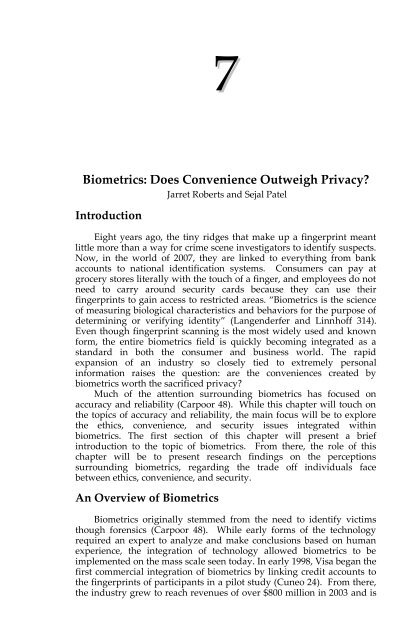
![Download Entire Book [PDF] - Ethicapublishing.com](https://img.yumpu.com/19531485/1/190x245/download-entire-book-pdf-ethicapublishingcom.jpg?quality=85)
![Download Entire Book [PDF] - Ethicapublishing.com](https://img.yumpu.com/19531484/1/190x245/download-entire-book-pdf-ethicapublishingcom.jpg?quality=85)
